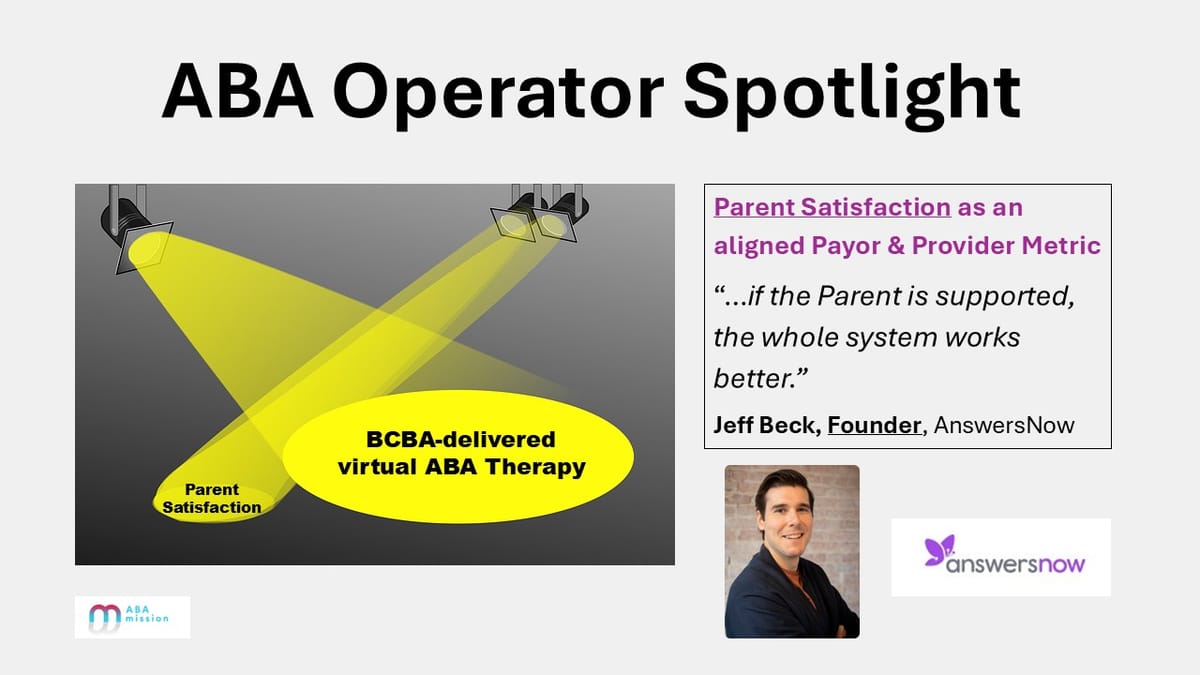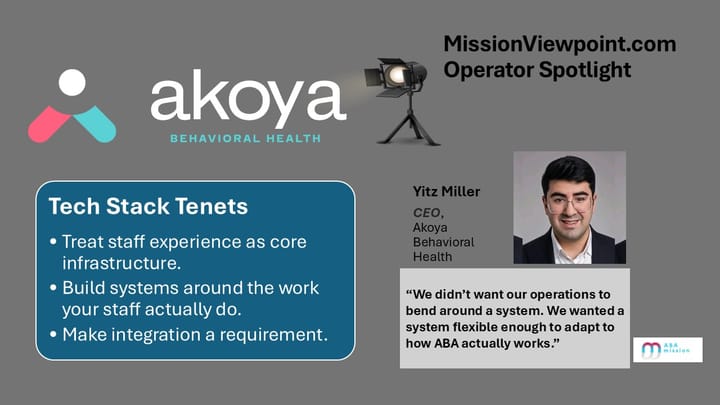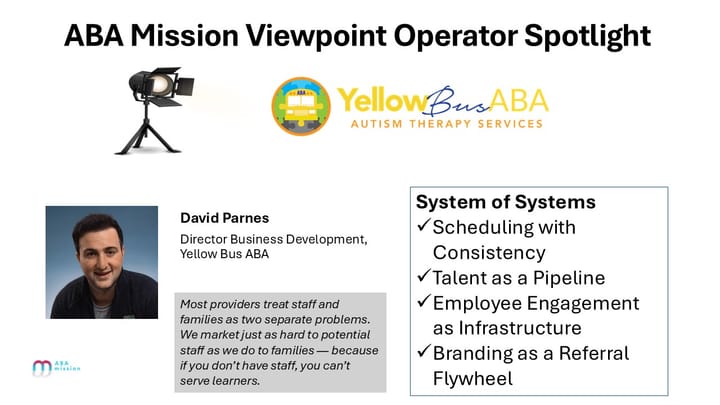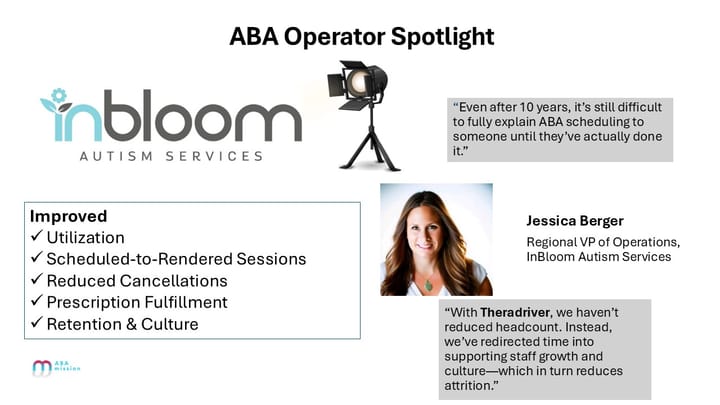Operator Spotlight: AnswersNow -> BCBA-led. Tech-enabled. Outcome-focused.

BCBA-led, AI-enabled, and redefining how we think about outcomes in ABA
One of the reasons I started this Operator Spotlight series was to highlight ABA providers who are using technology—not just for bells and whistles, but to build scalable, sustainable care models. So when I sat down with Jeff Beck, founder of AnswersNow, I expected to learn more about their platform and the tech stack powering their virtual care model.
What I didn’t expect was to leave with a very different understanding of who they are.
AnswersNow isn’t a platform trying to be a provider—it’s a provider that just happens to build really good tech.
And not just good tech, but a whole care delivery model that’s challenging some of the assumptions I’ve held about what outcomes should look like in ABA, and how payors might actually be convinced to care about them.
A Different Kind of Model—BCBA Only, No RBTs
The first thing that stands out about AnswersNow is what’s not part of their model: RBTs. All therapy is delivered by licensed BCBAs, virtually. That’s not a knock on RBTs—but rather a reflection of the kinds of learners Jeff’s team focuses on: primarily level 1 autism, often in the 5–12 age range, who don’t need 30+ hours a week and aren’t well served by traditional center-based models.
For this population, Jeff argues (persuasively) that a BCBA can do more, faster, without the overhead of supervision and delegated protocols.
“We’re seeing that a BCBA, empowered to amend protocol in real time, can deliver equivalent or better outcomes with fewer hours. That’s good for the kid, the family, and the payor.”
It’s a bold statement, but it tracks—especially when the sessions are virtual, the learners are verbal, and the therapy is parent-inclusive.
The Outcome That Everyone Cares About: Parent Satisfaction
Now here’s where Jeff really changed my thinking.
Like many in the field, I’ve long lamented the lack of consensus on clinical outcomes in ABA. Every payor wants something different. Every provider reports something different. And that disconnect often stalls progress—especially when talking about value-based care (VBC).
But AnswersNow has found a surprisingly powerful common denominator: parent satisfaction.
It’s simple. It’s measurable. And most importantly, everyone cares about it—from the clinician to the payor to the legislator. A happy, confident parent means better adherence, fewer complaints, and most likely, a child who’s making progress.
“We start there,” Jeff told me. “Because if the parent is supported, the whole system works better.”
Pair that with standardized Vineland scores to track functional improvement, and you’ve got something that feels both human and rigorous—enough to convince payors to sign on.
This doesn’t mean the debate around outcomes is settled. It’s not. But it does feel like a starting point that resonates with every stakeholder—and for now, that may be the most important kind of progress.
Value-Based Care Is Happening—But Slowly
Jeff didn’t sugarcoat it. Their first VBC contract took 24 months to finalize. But once payors understand the model—and see the impact on families—they align fast.
AnswersNow is now in the process of flipping one of its longest-running Medicaid partnerships from fee-for-service to VBC. While not yet finalized, the progress suggests growing payor confidence in their model.
It’s a slog, but it’s happening.
The Tech Is Quietly Sophisticated
While AnswersNow isn’t a “platform,” their internal tech stack deserves credit:
- Custom-built clinical + practice management tools
- HubSpot (HIPAA version) for CRM and intake
- Automated scheduling and workflow support
- 8-week onboarding and weekly tech/clinical supervision for BCBAs
- Ongoing training in AI tools like Gamma to help clinicians streamline documentation and planning
And while much of their AI story is centered on clinician enablement—training BCBAs to use tools effectively in session planning—it’s hard not to wonder what’s possible down the line. Given the sheer volume of virtual care they’ve delivered, I wouldn’t be surprised if they’re quietly building something deeper behind the scenes. In a field where data is often fragmented or underutilized, that kind of asset could eventually become a serious differentiator.
Medicaid Cuts? Maybe. Collapse? Unlikely.
Jeff and I also spent time discussing the impact of proposed Medicaid cuts. While some view this as an existential threat to ABA, I think the impact will be muted. Political pressure from parents—and the emotional visibility of autism care—make it unlikely that cuts will be either dramatic or sustained.
AnswersNow’s model may be especially well-suited to that reality: virtual delivery, efficient staffing, and a focus on learner-fit care that doesn’t chase maximum billable hours. Jeff’s take? Stay focused and keep building for long-term sustainability.
What’s Next? Maybe B2B
Right now, AnswersNow doesn’t offer subcontracted services to other providers—but it’s easy to imagine a future where they do. With a national BCBA workforce, strong outcomes, and payer relationships already in place, the model is well suited to support ecosystems where commercial ABA providers partner with the likes of Easterseals or Catalight on ABA service augmentation.
Jeff’s not pushing there yet—but the infrastructure feels ready when the time is right.
Final Thought: A Provider First, With a Platform Mindset
I left the conversation with Jeff seeing AnswersNow in a completely new light.
They’re not building for the mainstream ABA model. They’re building for the future—for a world where:
- More kids have level 1 autism diagnoses
- Parents are demanding virtual, flexible options
- BCBAs want to deliver care directly
- Payors are (finally) willing to pay for outcomes instead of just hours
And in that world, parent satisfaction might just be the clearest outcome we’ve got.
It’s not perfect. The road ahead still requires education, alignment, and lots of payor engagement. But in a field still struggling to define its benchmarks, AnswersNow is showing what one might look like.



